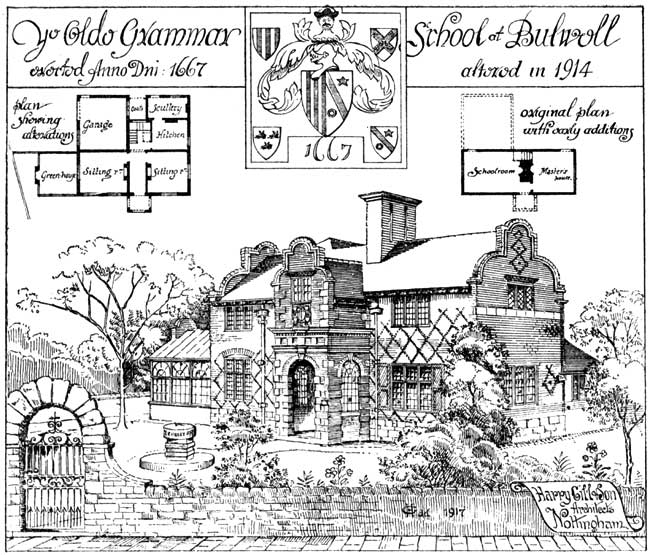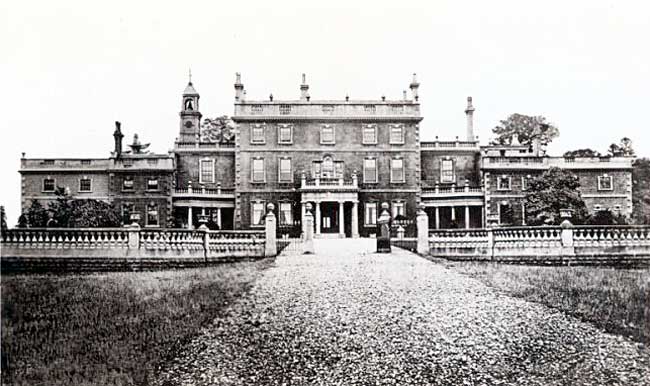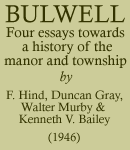This district was almost the centre of the framework-knitters. To be seen yet in Hempshill Lane are two houses with the lean-to workshops at each side. Where Buckingham Road now is used to be the site of Sankey's pottery, with its kilns and sheds. The clay at that time was got from where the council houses are built in Hempshill Lane. Across the way, just past Gilead Street, is a date over an old outhouse to a cottage which takes us back to the year of Waterloo—1815. Round the bend is the Red Lion Inn, where the first horse-buses used to draw up and turn round. In the field just behind, sixty years back, I saw the fox-hounds kill the fox. I was working at the brickyard, and saw the fox come over the railway towards Mr. T. Holmes's quarry. He hid himself in a fowl-house till the hounds chased him out of it, then up the bank he went, but they cornered him at the end of the field. As I saw the whipper-in cut off the head, paws and tail, blood the young lady who was first in the field, and then throw what was left of the fox to the hounds, I thought as I walked back to my work that a lot of them could easily have been employed to a more useful purpose.
We now get to where the stone-quarrying and lime-burning had been carried on for hundreds of years. Beginning in the neighbourhood of the police station, it stretched to the extreme top of Bulwell, near the pit. Practically all this section of Bulwell is built on the lower level where the stone has been quarried away. The old Primitive Chapel used to stand where the present one now is. There was a delightful country lane went up the side of it to the fields beyond. The date of the Chapel was 1852, so that it was two years younger than our present parish church.
At the entrance to the stone quarries, near the Bulwell Colliery, now closed, is our old village pinfold. In these days of petrol transport and paved streets, the need for the stray catde enclosure has passed out of mind. I well remember one of our old pinders. To tease him, we used to shout after him, "Who put the geese in the pinfold?" and then name him. He would then pretend to be annoyed and shake his stick at us.
It would be interesting to deal with Blenheim and the old Bulwell Wood Hall, but as that district is now in the parish of Hucknall, we had better wait and see. Coming back down Quarry Road, now Commercial Road, there was a fine house in its own grounds opposite the Quarry Road Schools. It had a carriage drive and extensive private gardens stretching back to what is now Rock Street. Lower down, across from Belgrave Street, used to stand the home of the village clerk, Mr. Wilkinson. This house was known as Hol-Wood or Hall Wood House. The police station was our council house till we were joined to the City in 1877. Council meetings were held in the big room upstairs which at one time was our reading-room. In the entrance to Coventry Road you will notice two old cottages facing towards the pit. These are evidently older than those lower down whose date is 1833—the same year in which the old bridge was built.

We now come to what, from the angle of this paper, is our choicest spot —Strelley House—possibly the best building of its period and type in the whole City. Robbed of its old-world situation and now fronting the passing of modern traffic, it was built in 1667 by George Strelley of Hempshill Hall. With thanks to Mr. Frank Chambers for its preservation, we are proud of it, and glad of its beauty and history. The boys of Bulwell at that date used to have to go to Nuthall for their schooling, and there would not be many parents who could send them and bear the cost. For the sake of the "poor boys" of Bulwell, Strelley built and endowed the school to accommodate thirty boys. The foundation deed of 1669 declared that the Hon. William Byron of Bulwell Wood Hall should be the governor, with Richard Slater of Hucknall, Daniel Chadwick, minister of the parish of Bulwell, William Strelley of Arnold, and Edward Cludd of Norwell Park as assistants. "The sum of 6s. 8d. to be spent annually on cakes and ale for their accommodation". One of their duties was to have distributed at the parish church each Sabbath six threepenny loaves to the poor and needy. When, with the changing times, the school was closed down, the Charity Commissioners invested the capital, which now provides four scholarships of £15 each for three, four or five years at the Nottingham High School. Mr. Arthur Buxton, manager of Sankey's pottery, was the first Bulwell boy to get the grant. To describe the school would take too much space; it is there for all to see who are interested, and it is the wish of many that it should be preserved for future generations of Bulwellians. I would add that the old oak-studded door which stands back beyond the pear-tree used to be the door of the old church, a painting of which is hung in our present church. I have a photograph showing the oldest inhabitant (the late Mr. Thomas Holmes) standing under the oldest pear-tree, by the oldest house.
Across the road from Strelley House used to be Shipstone's house and blacksmith's shop, possibly the oldest house in Bulwell. Before being owned by several generations of the Shipstones, it had been the property of Mr. Padley, the lord of the manor. Robinson's Hill has some very old buildings, including the blacksmith's shop owned by Mr. George Walker.
Opposite the Church Institute, leading down to Main Street is Duke Street. The curbed and paved footpath is twelve inches wide on one side and eighteen inches on the other. The row of very old cottages has been scheduled for demolition many years now, but some of them are still occupied. I do not know of any complete row of houses now left of a similar style and age. Beech House, nearby, which at one time stood in a suitable setting, and had a carriage drive and gateway off Main Street, is now penned in by streets and cottages. It was once the home of "Gentleman Walker" as we always named him. I am told that it was built by one of his family who went by the name locally of "Rattle-Jack Walker." A smooth, gassy sort of coal used to be carted from Bulwell to the gasworks at the price of one shilling per ton for transport. If the horse was strong enough and the cart big enough, and thirty hundredweight was taken, the princely sum of one-and-sixpence would be earned. If my information is correct, Mr. Walker would be a contractor. In the year 1815, the Misses Walsh, two maiden ladies, kept a "superior" school for girls at Beech House.
Hazel Street once contained, within living memory, a long row of three-storey houses the top rooms of which were used as frame-shops. It was here that the first Wesleyan Chapel was built. Previous to this, the Wesleyans used to meet in a cottage in the "Old Building" off Newstead Street. The date of the building is 1811. From a slight knowledge of the times with their low wages, war and hunger, transportation for very slight offences, and the continual threat of invasion, we can readily see that these early Nonconformists must have held their freedom to worship in their own way very dearly to have built this chapel and supported it in such disturbed and poverty stricken times.
The old Bulwell Green is far different now from my first memories of it sixty years back. There are still some of the old cottages left occupied, but the next few years will see them disappear. One old house, now gone, was occupied for many years by the Read family; its old name was Bull-frog Hall. We must conclude that, to have a name like that, there must have been a pond close by. The National School or Trust School is still doing good service, although not structurally up to modern requirements. The builders of it put some really good work into its style and construction, and it is to be hoped that, when a change becomes necessary, the main structure will be preserved to Bulwell for some community or cultural purpose—why not a local museum and art gallery? It was built in 1866 at a cost of £3,000, providing for 518 children. Over the door in Main Street is a small group, carved in stone, intended to represent the origin of the village name—Bull-well. How far this legend is correct, it is risky to say. One authority traces the name to a Saxon word which means "bubbling or singing", owing to the gurgling noise made by the water as it gushed forth from its rocky prison as if glad to be free.

Bulwell Hall, c.1920.
Bulwell Hall must be our next item. It was built in 1770 by John Newton, Esquire, who was annoyed to find that the Bulwellians named it Pye-wipe Hall. "Pye-wipe" was a general name for plovers or peewits, which would at that time be very numerous in the district. It was bought for the City in 1908 by Sir Albert Ball, the Hall and estate including 574 acres of land, mineral rights, etc. It is said that one of the Bulwell Jennisons, who started the Bellevue Zoo at Manchester, missed the sale because the train was half-an-hour late. It was his intention to buy the Hall and start the Zoo at Bulwell instead of Manchester. It taxes the imagination to picture what Bulwell would be like to-day if the train had run to its proper time.
Forge Mill is clearly associated with the industrial history of Bulwell, and is a building of great local interest, but it is outside our parish and consequently outside this short sketch. The Springfield Works date back to remote times; it is understood that before the Midland Railway came along, the bridge over the Leen went either through the mill or near by. Several sections of the old building still remain. At the Central Library we have a very clear photograph of the old water-wheel. One of my friends, who had a garden close to the mill, told me that a part of it was useless as a garden because a section of the old macadam road ran across it. This mill has an old legal claim to the water from Bulwell, which accounts for their having the water piped from the well to the works. This beauty spot has sadly altered during die last few years; the picture by McArthur showing the windmill above the well depicts a scene in vivid contrast to the present rubbish dump. An old account shows that a Mr. Drury paid to the lord of the manor the sum of two shillings per annum as rent for the mill, it being in what is now the forest. Coming down Hucknall Lane towards Bulwell, we pass the lovely old residence recendy occupied by the late Mr. E. Widdowson, with its once extensive gardens, now greatly spoilt in extent and outlook by the viaduct carrying the traffic of the Great Central Railway.
This short record would not be complete without some mention of what we used to term "The Old Buildings", now mainly demolished. Allow me to indulge in a few personal recollections at this stage. I remember that when my parents brought me to Bulwell sixty-eight years back, we had lodgings with a milkman named Pollard, who lived in the big three-storey shop in Austin Street. This house at one time had been the Forest Inn, and later the Queen Adelaide; the beer-cellars, I am told, are still used and in good condition. The gorse and ling at that time came down to the railway crossing. Hearing a brass band as I was making sand-pies with a blacking-pot, I remember my mother picking, me up in her arms and hurrying down to see the Yeomanry coming to pitch tents for their annual training. Where the Newstead Abbey Inn now stands were gardens at that time. To prevent the catde rambling into Austin Street there were several stout posts across the pathway. The coming of the railway, the extensive number of dwelling-houses and other alterations have made it difficult to remember the rural beauty of bygone days.
In conclusion, and for the sake of a few of the old Bulwellians, I will quote a few names and particulars of a hundred years ago. We then had a population of 3,157 inhabitants, an acreage of 1,628 acres, with 140 acres of unenclosed forest land. Bulwell Hall was then known as Bulwell House. An account written in 1844 states that "a new church is about to be erected in the village by subcription . . . The Rev. A. Padley has given £600, Mrs. Bolton of Hemshill (Hempshill), in Greasley parish, £300; it is intended to erect a handsome structure at a cost of about £2,500 of which the main amount is already promised".
Here are a few names and trades of this period: —Charles Allcock, bleacher; Edward Bonner, chemist; Robert Stanser Bowker, surgeon; Joseph Calladine, schoolmaster; William Cartlege, lace manufacturer; John Chambers, plumber; William Dawson, schoolmaster; Arthur Ebsworth, surgeon; Richard Francis, farrier; Richard Sansom, market gardener; Mark Truman, framesmith; Richard Jennison, Goodacre Sills, George Walker, blacksmiths; E. Brocklehurst, Samuel Cox, George Finch and Henry Moore, boot and shoe makers. At this time, blacksmiths and shoe-makers worked in the evenings, because colliers' picks needed sharpening for the next day's work, and broken shoes had to be mended then as most labourers had only the one pair for all purposes.
A number of our prominent people had their fingers in more pies than one. Charles Allcock is mentioned as bleacher, corn miller, bone crusher and farmer; how he spent his spare time is not recorded. Space does not permit me to quote extensively, and old Bulwell names are numerous. To mention only a few, we have J. Gent, G. H. Leivers, S. Oldham, E. Charles, A. Faulconbridge, J. Fox, J. Weston, J. and R. Tilley, James White, W. Brooksby, and Charles Smith of the Scots Greys. If the mention of these names calls up memories, I ask you to bear with me a little longer. Our old village had outstanding personalities and a charm of its own. Detached as we were from the City, we went our own way and do so still, in a limited measure. When the lord of the manor wanted to claim the bogs, we pushed him back to his proper place; when the Prior of Newstead overstepped his authority, we fought him to a finish. Our old market place has seen meetings more forcible than polite for hundreds of years, and is still the cock-pit in critical times.
As a lad, I could sit in the house and hear the cuckoo and the corncrake; in our woods you could see the bullfinch, and in and by our streams the trout and the kingfisher. There was, however, another side to the picture. Many of our older people were badly disfigured by small-pox marks, and infants died in hot weather like flies. Our sanitation left much to be desired: the long-drop closets which were emptied twice a year produced flies by the million. Lads of tender years were at work by six o'clock in the morning in the depth of severe winter weather, and consumption took an awful toll of our mill-girls. It might be said, "Yes, but look what big, fine men and women there were at that time!" My answer would be, "The survival of the fittest". When I think of our dear, dirty, straggling old Bulwell, which has never been planned but, like Topsy, "just growed", and think what could be made of it by thought and goodwill, the contrast is discouraging. Instead of our Leen being an open sewer for trade waste and rubbish which the dustmen will not take, filling up with weeds and rushes, in times of floods running into houses and shops and putting people to all sorts of unnecessary trouble and expense, think of it as cleaned and properly banked, a delight to children and a source of pleasure to all who live by its banks. Some of us older ones will shortly have to retire from the field, leaving much worth doing still undone. If any ideas of mine can prompt others to remould this sorry scheme of things nearer to the heart's desire, our efforts will not have been wasted.
In conclusion, I wish to thank all who have helped me in any way. These notes, in places, are perhaps not strictly accurate; they are, however,, as correct as I could make them.
